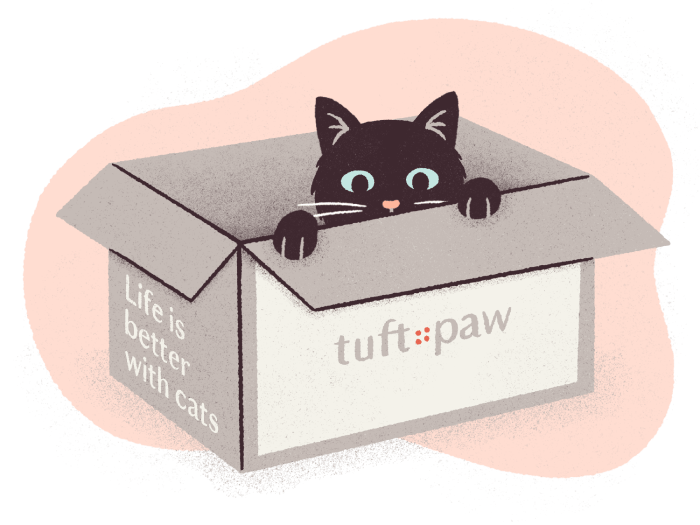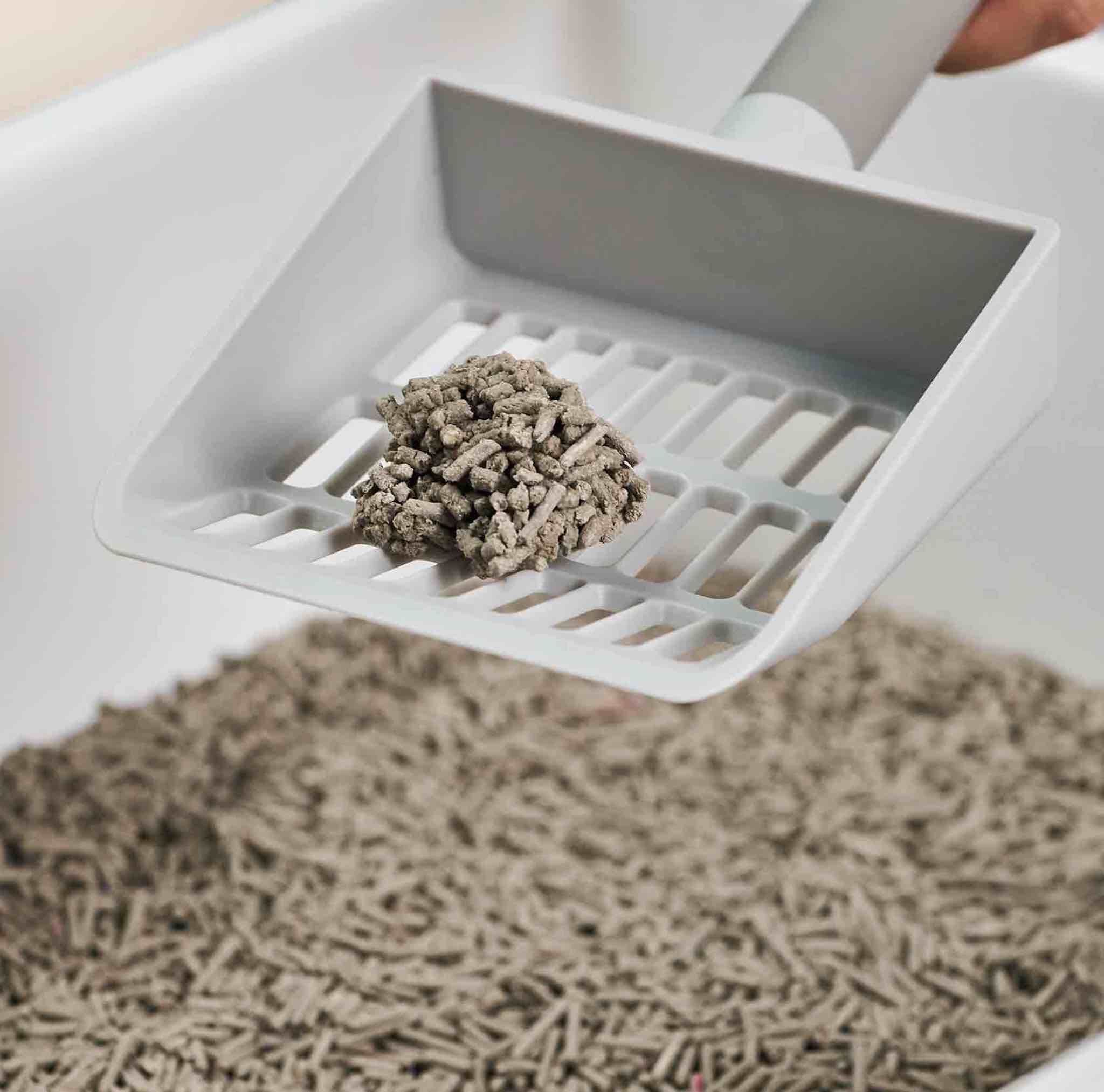Tofu litter and wood pellet litters are two of the most popular natural litter options on the market, but cat parents used to clay litter may still have some lingering questions about these products. What exactly is tofu litter? What are wood pellets? Is one better than the other? In this article we'll give you everything you need to make an informed decision about which litter is right for you.
Here at tuft + paw, we are cat experts. We're intimately familiar with which litter features are most important to cats and cat parents alike. To create this article, we consulted a cat behaviorist, veterinarian, and hundreds of online reviews.
For brand recommendations and a deeper dive on each litter type, check out our lists of the best tofu litters and best wood pellet litters.
If you want answers on tofu vs wood ASAP, click here → Jump to Final Results
What is Tofu Litter?
Tofu litter is a natural cat litter made from soybean fiber and usually comes in the form of thin pellets. The fiber is a waste product from the soy milk industry, making tofu litter both sustainably sourced and biodegradable. Performance-wise, tofu litter's biggest strengths are its low tracking pellets and very low dust content. Furthermore, almost all tofu litters offer excellent absorbency, flushability, and decent clumping to boot. Some brands include scents or colors in their formulas—think green tea and vanilla—but we recommend staying away from these, as they can cause your cat to avoid the litter box.

A compact, all-in-one litter box that's easy-to-clean and keeps messes contained.
View Product
What Is Wood Pellet Litter?
Wood pellet cat litter is pretty self-explanatory—it's made from finely ground wood shavings that are compressed into absorbent pellets. To improve odor control or add clumping capabilities, some companies include natural additives like baking soda or plant starches in their formula. Wood cat litter come in two main styles - small clumping granules and larger non-clumping pellets. In this article, we'll be talking about the more popular non-clumping pellet style.

Head to Head: Tofu Litter vs Wood Pellet Litter
In order to best judge the pros and cons of these two litter types, we will be comparing their performance in 13 different categories. Each category is worth 1 point. Ties are possible if we consider the litter types equal in that category. Let the games begin!
1) Eco-Friendly Sourcing
Both tofu and wood pellet litters are made from plant-based byproducts of other industries. Tofu litter is made from the soybean fiber left over from soy milk manufacturing, while wood pellet litters are made from the scraps and sawdust of lumber processing. Wood and soy are both renewable resources, and their sourcing causes less environmental damage than mining for clay or silica. We consider both to be eco-friendly natural litters.
Winner: Both
2) Biodegradable
Both tofu litter and wood pellet litters are made from completely biodegradable materials. Unused litter can even be used as compost in some cases!
Winner: Both
3) Non-Toxic
Both tofu and wood pellet litters are non-toxic to cats and humans, though there are some caveats:
Any purpose made wood cat litter will be kiln-dried, which evaporates essential oils and phenols that are toxic to cats. If not kiln-dried (which is rare), wood pellets can pose some danger to cats. There is also the matter of carbon monoxide off-gassing; if stored in large quantities (e.g. dozens or hundreds of bags of wood pellets) in a poorly ventilated room, wood pellets can release dangerous amounts of carbon monoxide. Of course, cat parents are not likely to store that many wood pellets at once, so this is not a serious threat.
On the other hand, tofu litter does not pose any health threats that we're aware of. As a food-grade material, it is completely non-toxic unless the manufacturer decides to add some kind of problematic compound (e.g. preservatives).
Winner: Tofu (by a slim margin)
4) Flushability
Tofu litter is almost always flushable. The dehydrated soybean fibers expand when wet and quickly dissolve when fully submerged in water. Wood pellet litter is not usually advertised as flushable and we do not recommend flushing it unless the brand explicitly says so. If you're looking for a flushable wood cat litter, some granular ones offer this feature.
Note: Only flush litter if your cat lives indoors, is not fed a raw meat diet, and flushing litter is legal in your city.
Winner: Tofu
5) Ease of Cleaning
Tofu and wood litter can both be easy to clean, but they excel in different types of litter boxes.
In a regular litter box, tofu litter's clumping and flushability make it easier to clean than wood pellets—just scoop poops and pee clumps like any other clumping litter. The problem with non-clumping wood pellets is that they break down into sawdust when wet. In a regular litter box, this sawdust can accumulate quickly and be a hassle to remove.
Where wood pellet litter really shines is in a sifting litter box—every day or two, just give the litter box a shake and all the accumulated sawdust will sift down to the bottom pan of the litter box, leaving clean pellets up top. Scoop solid waste as usual. It's certainly a different technique, but with practice many cat parents find this wood pellet/sifting litter box combo to be easy and efficient.
Overall, tofu is probably more versatile and easier to use, but wood pellets are very effective with the right litter box setup.
Winner: Both — tofu in a regular litter box, wood in a sifting litter box
6) Tracking
Both tofu litters and wood pellet litters come in the form of low-tracking pellets. Pellet litters generally track less than granular litters because the pellets are heavier, less dusty, and don't stick to paws as easily. However, tofu does have a slight edge in this department because it doesn't break down into sawdust when wet. As wood pellet litter absorbs more liquid waste over time, the pellets will break down and become dustier and more prone to tracking if used in a regular litter box. As we mentioned above, cat parents can avoid this problem by using wood pellets in a sifting litter box.
Winner: Tofu
7) Dust
Once again, tofu has an advantage in the dust department because it doesn't break down into sawdust when wet. Everything we said in the last section applies here. In the grand scheme of litter types, we consider wood pellets to be medium to low dust, and tofu to be very low dust. Both are certainly much less dusty than clay.
Winner: Tofu
8) Paw-Friendly Texture
Pellet litters like tofu and wood are less comfortable on the paws than fine grain litters like clay. Wood pellets are usually fairly large and firm, sometimes with rough surfaces and edges. Tofu pellets, by contrast, are thinner, smoother, and slightly softer, so we consider tofu litter to be the more paw-friendly litter type. Most cats will still use pellet litters, but those with sensitive paws may not.
Note: There is always a tradeoff between a "paw-friendly texture" and "low tracking" in a cat litter. Larger litter particles will track less but will also be less comfortable to use. Small litter particles are more comfortable but will track easily.
Winner: Tofu

9) Odor Control
Of all the natural litter materials, wood might have the best inherent odor control (assuming no added deodorizers). It's absorbent, anti-bacterial, and has a scent that most people find pleasant.
Tofu litter doesn't have bad odor control per se, but soy fiber doesn't have any odor-neutralizing properties of its own beyond being absorbent. Some tofu litter brands add a deodorizing agent (e.g. activated charcoal) to strengthen the odor control, while others add synthetic scents (which we don't recommend).
Winner: Wood
10) Cat-Friendly Scent
The flip-side of wood litter's natural odor control is that cats don't always like the smell. As a rule of thumb, cats aren't fans of any herbal fragrance that you could imagine as an essential oil. The feline sense of smell is 14x more powerful than humans', so any scent that's noticeable to us can be downright overwhelming to them. On the other hand, unscented tofu litter has a fairly mild scent that cats have no problem with.
Winner: Tofu
11) Lightweight
Clay litter is notorious for being outrageously heavy. Thankfully, both tofu and wood litters are waaaaaay lighter and much less dense. However, keep in mind that wood pellets are usually sold in much larger bags than tofu litter (~40 lbs vs ~10 lbs), so you still may want help carrying them home.
Winner: Both
12) Spoilage
Many softwood tree species used to make wood pellets, like pine or fir, are naturally anti-bacterial, anti-fungal, and insect-repellent. This makes wood pellets almost spoil-proof. Conversely, tofu litter is more susceptible to spoilage from mold because it's made from a food byproduct. We always recommend storing natural litter in a cool, dry, well-ventilated area to avoid this problem.
Winner: Wood
13) Price
Wood pellets are almost always cheaper than tofu litter. Tofu litter is typically priced around the $3/lb range, while wood pellets can range widely from $3/lb to $0.50/lb, though most fall around $1-$1.50/lb. On the extremely affordable end, cat parents thinking outside the box can get Tractor Supply Co horse bedding for even cheaper. Pellet for pellet, tofu litter lasts longer because only used litter is removed, whereas wood pellets eventually need to be tossed as dirty litter mixes with clean litter. Nonetheless, most wood pellet litter will end up being more cost-effective.
Winner: Wood
Final Results: Tofu Wins!
The final score is Tofu 10 - Wood 7. It was a close one, but tofu edged it out. Of course, both tofu and wood litter have lots to offer any cat household, and it all depends on what you and your cat prefer. Our litter scoreboard below shows the final tally.
| Tofu Litter | Wood Pellet Litter | |
| Eco-Friendly Sourcing | ✓ | ✓ |
| Biodegradable | ✓ | ✓ |
| Non-Toxic | ✓ | |
| Flushability | ✓ | ✓ |
| Ease of Cleaning | ✓ | |
| Tracking | ✓ | |
| Dust | ✓ | |
| Paw-Friendly Texture | ✓ | |
| Odor Control | ✓ | |
| Cat-Friendly Scent | ✓ | |
| Lightweight | ✓ | ✓ |
| Spoilage | ✓ | |
| Price | ✓ | |
| Final Score | 10 | 7 |
We slightly prefer tofu litter for its clumping, flushability, and overall ease of use in a conventional litter box. In fact, we believe so strongly in the benefits of tofu litter that we actually developed our own version and called it Really Great Cat Litter. Check it out if that's your thing, or you can take a look at some of our other educational resources below.
Suggested Reading
How to Switch Your Cat to a New Litter
The Ultimate Guide to Different Types of Cat Litter
How to Choose the Right Litter








